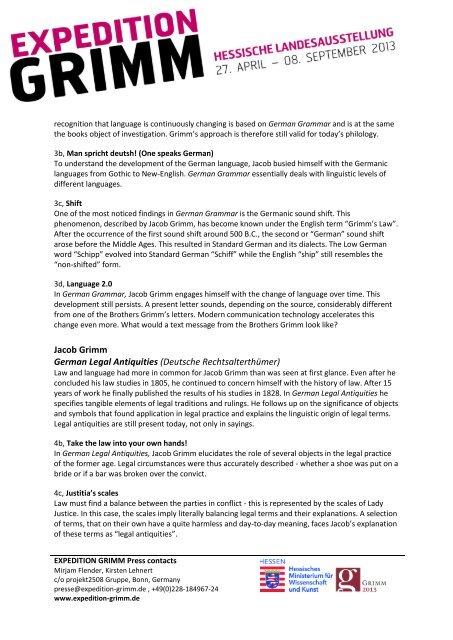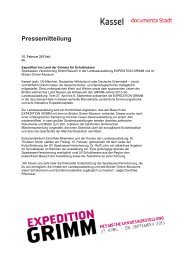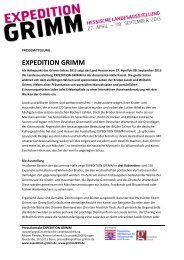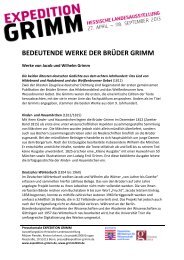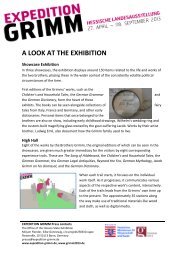Here - Expedition Grimm
Here - Expedition Grimm
Here - Expedition Grimm
Create successful ePaper yourself
Turn your PDF publications into a flip-book with our unique Google optimized e-Paper software.
ecognition that language is continuously changing is based on German Grammar and is at the same<br />
the books object of investigation. <strong>Grimm</strong>’s approach is therefore still valid for today’s philology.<br />
3b, Man spricht deutsh! (One speaks German)<br />
To understand the development of the German language, Jacob busied himself with the Germanic<br />
languages from Gothic to New-English. German Grammar essentially deals with linguistic levels of<br />
different languages.<br />
3c, Shift<br />
One of the most noticed findings in German Grammar is the Germanic sound shift. This<br />
phenomenon, described by Jacob <strong>Grimm</strong>, has become known under the English term “<strong>Grimm</strong>’s Law”.<br />
After the occurrence of the first sound shift around 500 B.C., the second or “German” sound shift<br />
arose before the Middle Ages. This resulted in Standard German and its dialects. The Low German<br />
word “Schipp” evolved into Standard German “Schiff” while the English “ship” still resembles the<br />
“non-shifted” form.<br />
3d, Language 2.0<br />
In German Grammar, Jacob <strong>Grimm</strong> engages himself with the change of language over time. This<br />
development still persists. A present letter sounds, depending on the source, considerably different<br />
from one of the Brothers <strong>Grimm</strong>’s letters. Modern communication technology accelerates this<br />
change even more. What would a text message from the Brothers <strong>Grimm</strong> look like?<br />
Jacob <strong>Grimm</strong><br />
German Legal Antiquities (Deutsche Rechtsalterthümer)<br />
Law and language had more in common for Jacob <strong>Grimm</strong> than was seen at first glance. Even after he<br />
concluded his law studies in 1805, he continued to concern himself with the history of law. After 15<br />
years of work he finally published the results of his studies in 1828. In German Legal Antiquities he<br />
specifies tangible elements of legal traditions and rulings. He follows up on the significance of objects<br />
and symbols that found application in legal practice and explains the linguistic origin of legal terms.<br />
Legal antiquities are still present today, not only in sayings.<br />
4b, Take the law into your own hands!<br />
In German Legal Antiquities, Jacob <strong>Grimm</strong> elucidates the role of several objects in the legal practice<br />
of the former age. Legal circumstances were thus accurately described - whether a shoe was put on a<br />
bride or if a bar was broken over the convict.<br />
4c, Justitia’s scales<br />
Law must find a balance between the parties in conflict - this is represented by the scales of Lady<br />
Justice. In this case, the scales imply literally balancing legal terms and their explanations. A selection<br />
of terms, that on their own have a quite harmless and day-to-day meaning, faces Jacob’s explanation<br />
of these terms as “legal antiquities”.<br />
EXPEDITION GRIMM Press contacts<br />
Mirjam Flender, Kirsten Lehnert<br />
c/o projekt2508 Gruppe, Bonn, Germany<br />
presse@expedition-grimm.de , +49(0)228-184967-24<br />
www.expedition-grimm.de


